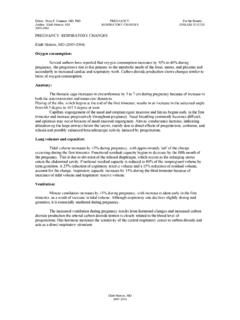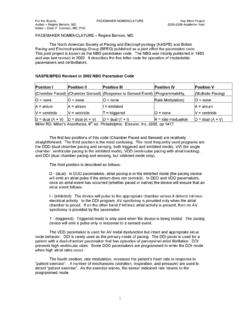Transcription of Editor – Dean F. Connors, MD, PhD
1 For the PLATEAU PRESSURE Key Word Project Author Michael Kissel, MD 2005-2006 Academic Year Editor dean F. Connors, MD, PhD 1 PLATEAU PRESSURE Michael Kissel, MD The plateau pressure (PP) is the pressure applied to small airways and alveoli. It is measured during an inspiratory pause on the ventilator. The goal plateau pressure is <30 cm H2O to prevent volutrauma; that is lung injury secondary to overdistension of alveoli. Without lung disease, peak inspiratory pressure (PIP) is only slightly above the plateau pressure. In cases of increased tidal volume or decreased pulmonary compliance, the PIP and plateau pressure rise together proportionately. If the peak pressure rises with no change in plateau pressure, increased airway resistance should be suspected or high inspiratory gas flow rates.
2 A list of causes of increased PIP with or without increased plateau pressure is noted below. One should note the relationship of plateau pressure with static compliance of the lung (Cstat). The formula for static compliance is as follows: Cstat= Vt/Pplat - PEEP (Normal static compliance is 50-100 mL/cm H2O ) Where: Cstat = Static Compliance of the lung Vt = tidal Volume Pplat = Peak Plateau Pressure PEEP = Positive End Expiratory Pressure Increased PIP and Pplat: Increased tidal volume Decreased pulmonary compliance Pulmonary edema Pleural effusion Peritoneal gas insufflation Tension pneumothorax Trendelenburg Ascites Abdominal packing Endobronchial intubation Increased PIP and Unchanged Pplat: Increased inspiratory gas flow rate Increased airway resistance Kinked ET tube Secretions Foreign body aspiration Bronchospasm Airway compression ET tube cuff herniation References: 1.
3 Morgan, Edward G., Maged Mikhail and Michael Murry. Clinical Anesthesiology, Fourth edition, 2006. McGraw Hill, Philadelphia. Pg. 82 2. Moon, Richard and Enrico Camporesi Respiratory Monitoring . Miller s Anesthesia, Sixth edition, Ronald Miller (Ed), 2005, Elsiever, New York.


